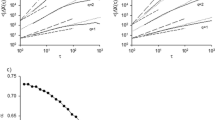Abstract
Fractal measurements of animal movement paths have been used to analyze how animals view habitats at different spatial scales. One problem has been the absence of error estimates for fractal d estimators. To address this weakness, I present and test 4 new estimators for measuring fractal dimension at different spatial scales, along with estimates of their variation. The estimators are based on dividing the movement path into pairs of steps, forming V's, and then estimating various statistics from each V.
I measured the performance of these estimators by comparing them to the traditional divider d method, using data generated by two different animal movement models. The estimator based on the net distance between the two steps and the cos turning angle was most accurate, giving estimates similar to those of the traditionally-used divider d method. Precision increased with longer and straighter paths.
Strengths of this new estimator are that it can estimate fractal d at different spatial scales, give an estimate of variation, and combine data from many separate path segments which have been gathered at various spatial scales.
Similar content being viewed by others
References
Benhamou, S. 1990. An analysis of movements of the wood mouseApodemus sylvaticus in its home range. Behavioural Processes 22: 235–250.
Boonstra, R. and Craine, I.T.M. 1986. Natal nest location and small mammal tracking with a spool and line technique. Canadian Journal of Zoology 64: 1034–1036.
Crist, T.O., Guertin, D.S., Wiens, J.A. and Milne, B.T. 1992. Animal movement in heterogeneous landscapes: an experiment withEleodes beetles in shortgrass prairie. Functional Ecology 6: 536–544.
Dicke, M. and Burrough, P.A. 1988. Using fractal dimensions for characterizing the tortuosity of animal trails. Physiological Entomology 13: 393–398.
Efron, B. and Tibshirani, R. 1991. Statistical data analysis in the computer age. Science 253: 390–395.
Goodyear, N.C. 1989. Studying fine-scale habitat use in small mammals. Journal of Wildlife Management 53: 941–946.
Kotliar, N.B. and Wiens, J.A. 1990. Multiple scales of patchiness and patch structure: a hierarchical framework for the study of heterogeneity. Oikos 59: 253–260.
Krummer, J.R., Gardner, R.H., Sugihara, G., O'Neill, R.V. and Coleman, P.R. 1987. Landscape patterns in a disturbed environment. Oikos 48: 321–324.
Lemen, C.A. and Freeman, P.W. 1985. Tracking mammals with fluorescent pigments: a new technique. Journal of Mammalogy 66: 134–136.
Mandelbrot, B. 1967. How long is the coast of Britain? Statistical self-similarity and fractional dimension. Science 156: 636–638.
Milne, B.T. 1991. Lessons from applying fractal models to landscape patterns.In Quantitative Methods in Landscape Ecology, pp. 199–235. Edited by M.G. Turner and R.H. Gardner. Springer, New York.
Sherry, T.W. and Holmes, R.T. 1988. Habitat selection by breeding American Redstarts in response to a dominant competitor, the Least Flycatcher. The Auk 105: 350–364.
Sugihara, G. and May, R.M. 1990. Applications of fractals in ecology. Trends in Ecology and Evolution 5: 79–86.
Wiens, J.A., Crist, T.O. and Milne, B.T. 1993. On quantifying insect movements. Environmental Entomology 22: 709–715.
With, K.A. 1994a. Ontogenetic shifts in how grasshoppers interact with landscape structure: an analysis of movement patterns. Functional Ecology 8: 477–485.
With, K.A. 1994b. Using fractal analysis to assess how species perceive landscape structure. Landscape Ecology 9: 25–36.
Zhang, Z. and Sanderson, J.P. 1993. Spatial scale of aggregation in three acarine predator species with different degrees of polyphagy. Oecologie (Berl.) 96: 24–31.
Author information
Authors and Affiliations
Rights and permissions
About this article
Cite this article
Nams, V.O. The VFractal: a new estimator for fractal dimension of animal movement paths. Landscape Ecol 11, 289–297 (1996). https://doi.org/10.1007/BF02059856
Issue Date:
DOI: https://doi.org/10.1007/BF02059856




